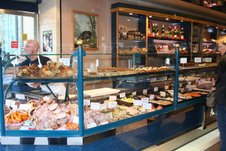Civita in Mission Valley Opens Farmers Market
(And, for transparency's sake, you'll notice that they are also now advertisers on San Diego Foodstuff for the next couple of months.)
The market is on a long, easy-to-navigate stretch of pavement in the park. Parking is easy, there are tables if you want to nosh on any of the variety of global dishes sold by vendors. And, when I was there, a clown was ready to face paint and Bruce Gemmell, co-founder and research director of the Art Science Complex held court at a table filled with paper and writing/coloring tools to work with kids and adults on art projects.
But, of course, you want to know about the vendors. According to market managers Tasha Ardalan and Brandon Janiss, there are about three dozen of them--mostly people they work with at the other markets they manage around San Diego County. So, many will be familiar to regular market shoppers, including Da-Le Ranch, Majestic Garlic, Pacifica Culinaria, and Kawano Farms.
I bought some beautiful young broccoli from IRC grower Felicia Venegas. I bought persimmons from Valley Center Growers, which also had some magnificent oranges (and they give huge orange samples, by the way). I had plenty of honey at home, but am eager to return to buy more from Bee Safe Honey, which also does safe and humane bee removal (it's how they get the honey). Need cheese? You'll find it at Thyme of Essence. You can start a succulent garden, or replenish your current one, with beautiful plants from Farmers Nerceri.
Hungry or thirsty from shopping? You can travel the globe along this stretch of market. There's Full Belly Barbecue, SoCal Lemonade, House of Bao, Chilanga with Mexico City street food, Bam! Bun! with Filipino dishes--both traditional, like citrus-infused Chicken Adobo, and vegan, Barbecue Pulled Jack Fruit--and Little Someone Hong Kong Cuisine. Owner Syrus Kwan will make you a Hong Kong-style milk tea made with strong black tea and condensed milk. At Yipao Coffee, you can get free-trade Colombian coffee roasted in San Diego. Aya Cafe makes and sells banana brittle, kale chips, and walnut butter.
Finally, for dessert, stop by Flora Bake Shop with the kids for gorgeously decorated vegan cupcakes baked by owner Camille Dumbrique. Or Donut, Hello's PB&J or S'mores mini donuts.
According to Ardalan, the market is expected to grow as more vendors join the line up. She also noted that if you don't have enough cash to pay vendors, you can stop by the market manager's booth and use your credit or debit card to get market tokens. There is a dollar surcharge.
The official farmers market address is 7964 Civita Blvd.
Print Page




































